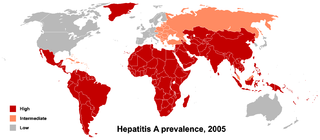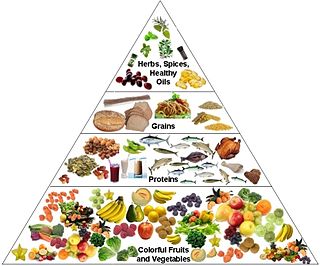Related Research Articles

Epidemiology is the study and analysis of the distribution, patterns and determinants of health and disease conditions in a defined population.
The science of epidemiology has matured significantly from the times of Hippocrates, Semmelweis and John Snow. The techniques for gathering and analyzing epidemiological data vary depending on the type of disease being monitored but each study will have overarching similarities.
An environmental factor, ecological factor or eco factor is any factor, abiotic or biotic, that influences living organisms. Abiotic factors include ambient temperature, amount of sunlight, air, soil, water and pH of the water soil in which an organism lives. Biotic factors would include the availability of food organisms and the presence of biological specificity, competitors, predators, and parasites.

Health geography is the application of geographical information, perspectives, and methods to the study of health, disease, and health care. Medical geography, a sub-discipline of or sister field of health geography, focuses on understanding spatial patterns of health and disease as related to the natural and social environment. Conventionally, there are two primary areas of research within medical geography: the first deals with the spatial distribution and determinants of morbidity and mortality, while the second deals with health planning, help-seeking behavior, and the provision of health services.

Spatial analysis is any of the formal techniques which studies entities using their topological, geometric, or geographic properties. Spatial analysis includes a variety of techniques using different analytic approaches, especially spatial statistics. It may be applied in fields as diverse as astronomy, with its studies of the placement of galaxies in the cosmos, or to chip fabrication engineering, with its use of "place and route" algorithms to build complex wiring structures. In a more restricted sense, spatial analysis is geospatial analysis, the technique applied to structures at the human scale, most notably in the analysis of geographic data. It may also be applied to genomics, as in transcriptomics data.

In epidemiology, Mendelian randomization is a method using measured variation in genes to examine the causal effect of an exposure on an outcome. Under key assumptions, the design reduces both reverse causation and confounding, which often substantially impede or mislead the interpretation of results from epidemiological studies.
Environmental epidemiology is a branch of epidemiology concerned with determining how environmental exposures impact human health. This field seeks to understand how various external risk factors may predispose to or protect against disease, illness, injury, developmental abnormalities, or death. These factors may be naturally occurring or may be introduced into environments where people live, work, and play.
Molecular epidemiology is a branch of epidemiology and medical science that focuses on the contribution of potential genetic and environmental risk factors, identified at the molecular level, to the etiology, distribution and prevention of disease within families and across populations. This field has emerged from the integration of molecular biology into traditional epidemiological research. Molecular epidemiology improves our understanding of the pathogenesis of disease by identifying specific pathways, molecules and genes that influence the risk of developing disease. More broadly, it seeks to establish understanding of how the interactions between genetic traits and environmental exposures result in disease.
TOXMAP was a geographic information system (GIS) from the United States National Library of Medicine (NLM) that was deprecated on December 16, 2019. The application used maps of the United States to help users explore data from the United States Environmental Protection Agency's (EPA) Toxics Release Inventory (TRI) and Superfund programs with visual projections and maps.
Geographic information systems (GISs) and geographic information science (GIScience) combine computer-mapping capabilities with additional database management and data analysis tools. Commercial GIS systems are very powerful and have touched many applications and industries, including environmental science, urban planning, agricultural applications, and others.

Nutritional epidemiology examines dietary and nutritional factors in relation to disease occurrence at a population level. Nutritional epidemiology is a relatively new field of medical research that studies the relationship between nutrition and health. It is a young discipline in epidemiology that is continuing to grow in relevance to present-day health concerns. Diet and physical activity are difficult to measure accurately, which may partly explain why nutrition has received less attention than other risk factors for disease in epidemiology. Nutritional epidemiology uses knowledge from nutritional science to aid in the understanding of human nutrition and the explanation of basic underlying mechanisms. Nutritional science information is also used in the development of nutritional epidemiological studies and interventions including clinical, case-control and cohort studies. Nutritional epidemiological methods have been developed to study the relationship between diet and disease. Findings from these studies impact public health as they guide the development of dietary recommendations including those tailored specifically for the prevention of certain diseases, conditions and cancers. It is argued by western researchers that nutritional epidemiology should be a core component in the training of all health and social service professions because of its increasing relevance and past successes in improving the health of the public worldwide. However, it is also argued that nutritional epidemiological studies yield unreliable findings as they rely on the role of diet in health and disease, which is known as an exposure that is susceptible to considerable measurement error.

The exposome is a concept used to describe environmental exposures that an individual encounters throughout life, and how these exposures impact biology and health. It encompasses both external and internal factors, including chemical, physical, biological, and social factors that may influence human health.
The non-profit Evidence-based Toxicology Collaboration (EBTC) comprises a group of scientists and experts with ties to governmental and non-governmental agencies, chemical and pharmaceutical companies, and academia that have banded together to promote the use of what are known as "evidence-based approaches" in toxicology. The discipline of evidence-based toxicology (EBT) is a process for transparently, consistently, and objectively assessing available scientific evidence in order to answer questions in toxicology. EBT has the potential to address concerns in the toxicological community about the limitations of current approaches. These include concerns related to transparency in decision making, synthesis of different types of evidence, and the assessment of bias and credibility. The evidence-based methods and approaches now being proposed for toxicology are widely used in medicine, which is the basis for their nomenclature. The need to improve how the performance of toxicological test methods is assessed was the main impetus for translating these tools to toxicology.
Environmental risk transition is the process by which traditional communities with associated environmental health issues become more economically developed and experience new health issues. In traditional or economically undeveloped regions, humans often suffer and die from infectious diseases or of malnutrition due to poor food, water, and air quality. As economic development occurs, these environmental issues are reduced or solved, and others begin to arise. There is a shift in the character of these environmental changes, and as a result, a shift in causes of death and disease.
A land use regression model is an algorithm often used for analyzing pollution, particularly in densely populated areas.
Elizabeth Anne (Lianne) Sheppard is an American statistician. She specializes in biostatistics and environmental statistics, and in particular in the effects of air quality on health. She is a Professor of Environmental and Occupational Health Sciences and a Professor of Biostatistics in the University of Washington School of Public Health. In 2021, Dr. Sheppard was named to the Rohm & Haas Endowed Professorship of Public Health Sciences.
Frederica Perera is an American environmental health scientist and the founder of the Columbia Center for Children's Environmental Health at the Columbia University Mailman School of Public Health. Her research career has focused on identifying and preventing harm to children from prenatal and early childhood exposure to environmental chemicals and pollutants. She is internationally recognized for pioneering the field of molecular epidemiology, incorporating molecular techniques into epidemiological studies to measure biologic doses, preclinical responses and susceptibility to toxic exposure.
Adrian Gerard Barnett is a professor in the faculty of Health in the school of Public Health and Social Work, at Queensland University of Technology and was president of the Statistical Society of Australia from 2018–2020.
SaTScan is a software tool that employs scan statistics for the spatial and temporal analysis of clusters of events. The software is trademarked by Martin Kulldorff, and was designed originally for public health and epidemiology to identify clusters of cases in both space and time and to perform statistical analysis to determine if these clusters are significantly different from what would be expected by chance The software provides a user-friendly interface and a range of statistical methods, making it accessible to researchers and practitioners. While not a full Geographic Information System, the outputs from SaTScan can be integrated with software such as ArcGIS or QGIS to visualize and analyze spatial data, and to map the distribution of various phenomena.
References
- 1 2 Elliott P, Wartenberg D (2004). "Spatial epidemiology: current approaches and future challenges". Environmental Health Perspectives. 112 (9): 998–1006. doi:10.1289/ehp.6735. JSTOR 3838101. PMC 1247193 . PMID 15198920.
- ↑ Ocaña-Riola R (2010). "Common errors in disease mapping" (PDF). Geospatial Health. 4 (2): 139–54. doi: 10.4081/gh.2010.196 . PMID 20503184.